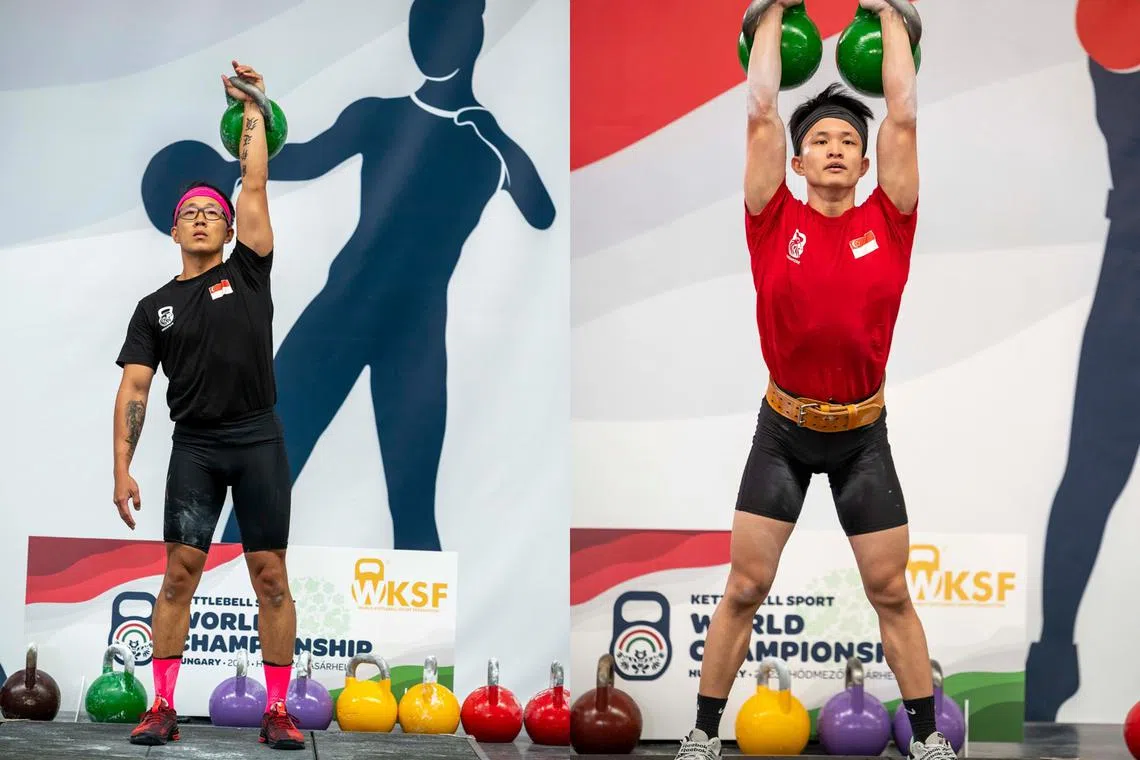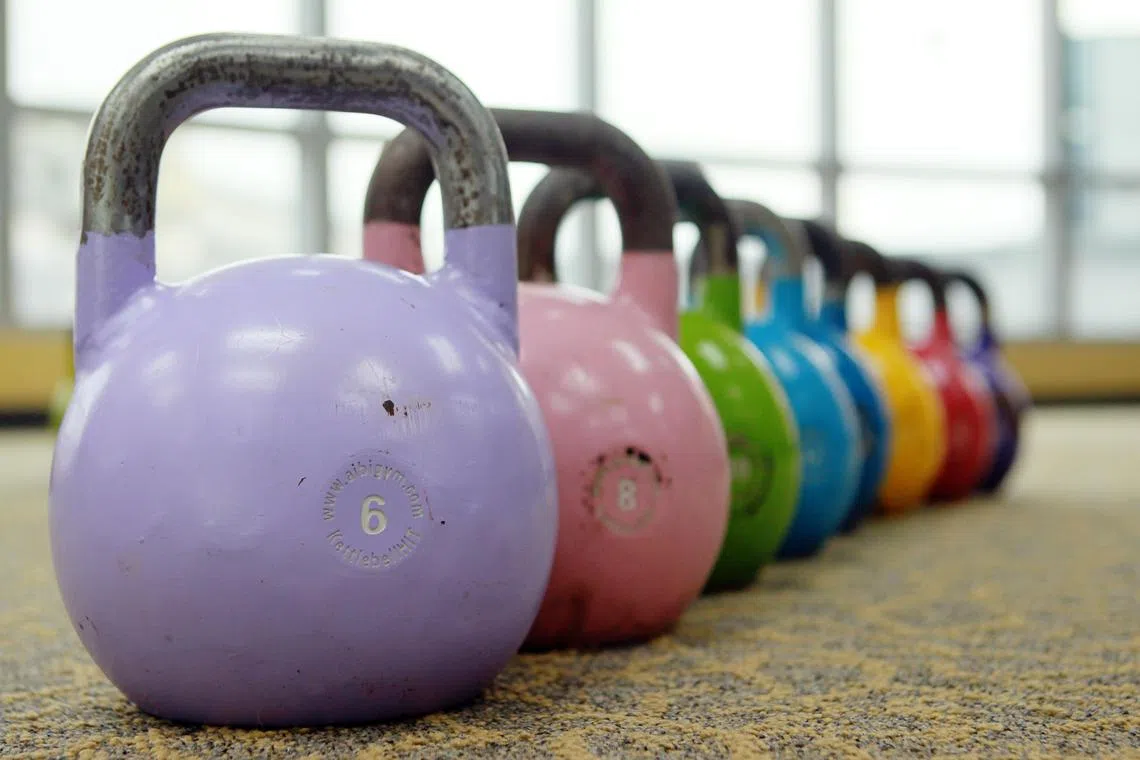Taking a swing with the kettlebell
A Singapore team of kettlebell competitors has achieved its biggest haul of medals to date at the 2024 Asian Kettlebell Championships in Taiwan

AT THE gym, most fitness junkies looking to build muscle tend to gravitate towards the usual suspects: dumbbells, barbells, weight plates – you name it.
But not Dexter Tay. His weapon of choice is the upright, unassuming kettlebell – and he wants you to know just how much of a punch the tool can pack.
Made of cast iron or cast steel, the kettlebell is a ball-shaped free weight with a handle attached at the top. It is available in a range of sizes, from as light as 2kg to up to 45kg or more.
Tay is a leading member of a small but growing team of semi-professional Singapore kettlebell competitors, whose recent showing at the 2024 Asian Kettlebell Championships in Taiwan was one for the books.
At the competition in May, the seven-strong team achieved its biggest haul of medals to date, with four golds and two silvers.
Tay and his teammate, Kayleigh Kho, set personal and national records in their individual weight categories. Both bagged gold in their respective events, with Tay achieving 140 repetitions in the male 24kg snatch category and Kho with 171 repetitions in the female 16kg snatch category.
A NEWSLETTER FOR YOU

Friday, 2 pm
Lifestyle
Our picks of the latest dining, travel and leisure options to treat yourself.
Versatile, inexpensive, accessible

The origins of the kettlebell date back to the 1700s in Russia, where it was first used as a tool of measurement to weigh agricultural goods. It later evolved to become a piece of strength and conditioning apparatus, favoured by Russian athletes and military personnel.
Much of the kettlebell’s rise in popularity in the West, however, can be credited to world record kettlebell lifter Valery Fedorenko, who brought the sport to the United States in 1999 and created the American Kettlebell Club and World Kettlebell Club Systems.
It was in 2011 that Tay was first introduced to the kettlebell at a training camp in Singapore – organised by none other than Fedorenko himself.
The freelance personal trainer soon realised that the kettlebell was an ideal choice of weighted equipment, as it took up little space and was comparatively cheaper to purchase.
“From a footprint perspective, it was something that I could put in my car and drive around, to offer as a resistance training option for my clients,” Tay tells The Business Times.
The kettlebell’s unique shape and design also allows for versatility in workouts, he adds. For instance, users can perform kettlebell swings, which involves swinging the kettlebell in a pendulum motion from between one’s knees up to chest height or eye level.
“The shape and small size of the kettlebell allows users to move the weight through space. In contrast, it’s hard to swing, say, a barbell because it’s too long and dangerous,” he says.

But the art of kettlebell lifting – or kettlebell sport, as it is recognised in the competition sphere – should not be underestimated.
Due to its wider range of achievable movements, the sport demands a higher level of technical proficiency than other forms of free weights, notes Tay, who recalls taking about three to four years to properly master the techniques.
The repetitive nature of kettlebell sport may also not be to everyone’s liking, he adds. The kettlebell competition format requires participants in each event – the snatch, jerk or long cycle – to perform as many repetitions as possible in 10 minutes.
Therein lies the challenge, but Tay believes a rewarding payoff is in store for those who can sustain their focus for that time period.
“It’s a great opportunity to boost mental well-being, because this isn’t something you can touch and go, (complete) one repetition and you’re done. It requires you to be present, to be very in tune with your breathing, and for some of us, it’s meditative.”
Growing the kettlebell sport community in Singapore
While kettlebell sport remains something of a niche globally, more people in Singapore have become acquainted with the iron ball through high intensity interval training (HIIT) classes in the last several years.
Tay notes that the integration of kettlebell-related workouts into CrossFit – an increasingly popular form of HIIT comprising functional movements – has boosted the equipment’s exposure among the masses.
In Singapore, there are some 300 to 350 active kettlebell training enthusiasts today, he estimates, up from just about 50 back in 2012. A few homegrown gyms such as AlphaFit and Strength Avenue also offer dedicated kettlebell sport training classes.
Meanwhile, 10 to 12 regulars turn up for training sessions with Tay’s kettlebell team, where he’s the head coach. The team – with an average age of 40, the youngest at 32 – trains two to three times a week.
“We wish to attract more young people to the sport, which is accessible financially and logistically – kettlebells are inexpensive to purchase, relative to home weightlifting equipment or treadmills,” says Tay.

Kettlebell sport could soon make its debut in future Summer Olympic Games too. International organisations have been advocating for the sport’s inclusion in the Games and are working towards getting approval, says Tay.
He hopes to set up a national sports association for kettlebell in Singapore by end-2025 to boost awareness of the sport and receive government funding. The team’s participation in overseas competitions is currently self-funded.
Still, its members are already gearing up for more. Next up is the International Kettlebell Organisation Malaysia Open in August, which will see the participation of 29 Singapore athletes – the largest contingent representing the Republic for an international kettlebell competition to date.
And in October, Tay and Kho will be heading to Greece for the World Kettlebell Championships in an attempt to achieve new personal best targets: 170 repetitions for Tay, and 200 repetitions for Kho.
Says Tay: “Kettlebells can help you get strong and fit. It’s not the only tool, but it’s definitely a tool that more people can start to understand and appreciate more.”
Copyright SPH Media. All rights reserved.


